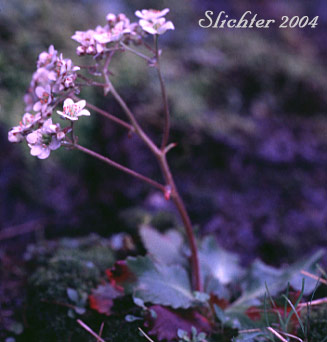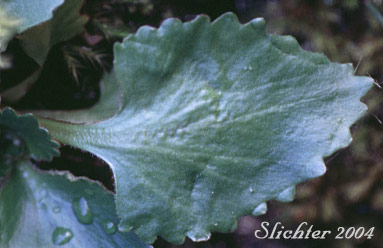
Saxifraga rufidula
formerly S. occidentalis var rufidula

 The
photo at right shows a close-up of the leaf blade and wide petiole of the rustyhair
saxifrage at right from the same location as above.
The
photo at right shows a close-up of the leaf blade and wide petiole of the rustyhair
saxifrage at right from the same location as above.
Also known as Alberta saxifrage, western saxifrage is a perennial with single, simple stems arising from 5-20 cm high from a cluster of several basal leaves. The stems arise from a short rhizome, are short-hairy, and are often strongly reddish- or purplish-glandular, especially in the inflorescence. The thick leaf blades are elliptical or egg-shaped, or occasionally roughly triangular in outline with coarsely toothed margins (15-30 teeth). The blade tapers gradually to a broad, winged petiole, or occasionally rather abruptly to the petiole, giving the leaf in that case a triangular outline. The blades are 2-5 cm long and to 3 cm wide and glabrous above and may be rusty-haired beneath.
The inflorescence is an open, generally flat-topped cyme with the long side branches greater than 5 cm long at flowering, and spreading to ascending. The pedicels range from 2-7 mm long. The reflexed calyx lobes are 1.5-2.5 mm long, triangular with rounded to obtuse tips. The white petals are 1.5-3.5 mm long, egg-shaped and without a claw at their base. They lack a pair of yellow dots at their base as seen in Idaho saxifrage. The filaments are awl- or narrowly club-shaped with both forms sometimes present in the same inflorescence. They range from 1.8-2.6 mm long while the orange-brown stamens are 0.25-0.5 mm long. The 2 styles are short and divergent.
Gorman's saxifrage Saxifraga gormanii (formerly S. occidentalis variety dentata): Filaments not petal-like, thinner or awl-shaped. Petals never have 2 yellow dots near their base. Inflorescence open, pyramidal, the branches spreading, greater than 5 cm long during flowering. Leaves narrow abruptly to long, thin petioles nearly as long as the blade. Inflorescence densely haired with short, purple- to red-tipped hairs. Found along the Columbia River from the western Gorge west to its mouth and south to Tillamook County in Oregon.
Idaho Saxifrage Saxifraga idahoensis (formerly S. occidentalis variety idahoensis): Filaments like thin petals, club-shaped, widest in the middle. Petals sometimes with 2 yellow dots near their base. Found from the foothills of the Wenatchee Mts. (Tumwater Canyon), in the lower basin of the Clearwater River of Idaho, and the lower Snake River Canyon of Idaho and Oregon.
Saddle Mountain saxifrage Saxifraga hitchcockiana (formerly S. occidentalis variety latipetiolata): Filaments not petal-like, mostly thinner, awl-shaped. Petals never have 2 yellow dots near their base. Inflorescence open, pyramidal, the branches spreading, greater than 5 cm long during flowering. Leaves gradually narrow to the short, wide petiole. Inflorescence densely haired with wavy, yellow gland-tipped hairs. Found on Saddle Mt and Onion Peak of Clatsop County, OR.
Western or Alberta Saxifrage Saxifraga occidentalis (formerly S. occidentalis var. allenii & var. wallowensis): Leaves basal, ovate with toothed margins . Inflorescence more congested, pyramidal, the branches ascending, greater than 5 cm long during flowering. Found along the east side of the Cascade mts at fairly high elevations from Mt. Rainier south to Mt. Adams and into the Columbia River Gorge. Also found west of the Cascade Mts.
Rustyhair saxifrage may be found on seasonally moist (spring) slopes, cliffs, and and streambanks from sea level to alpine habitats.
Rustyhair saxifrage may be found from British Columbia south on both sides of the Cascades to northwest Oregon, up the Columbia River Gorge to Wasco County in Oregon. It is found sporadically east of the Cascades in Washington and Oregon.